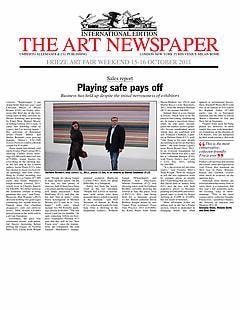
The Art Newspaper
October 15, 2011
Frieze Sales Report: Playing Safe Pays off
By Georgina Adam, Melanie Gerlis and Anny Shaw
“Surprisingly, I am doing better than last year,” said Christian Meyer of Meyer Kainer (G10) on Friday afternoon (the third day of the fair), citing sales of blue canvases by Heimo Zobernig and drawings by Franz West. Manuel Miseur of Johnen Galerie (H12) said: “I came not knowing what to expect, but I’m leaving happy.” His selection of Romanian artists—Florin Mitroi and Stefan Bertalan—was proving popular. Mitroi’s 9.XI.1986 (Green Portrait) sold to a British couple for €10,000.
Some stands had already sold out by Friday. Pilar Corrias (H7), showing Charles Avery drawings (£8,000 each) and a tall tree (£75,000), found buyers for everything on the opening day, in the fair and at her London gallery. Javier Peres (F21), who has chosen to focus exclusively on paintings, had sold everything by Friday, including two abstracts by Leo Gabin (€7,500 each) and Eddie Martinez’s rough-textured Untitled, 2011, which went to Charles Saatchi for $40,000. “It’s better suited to the economic climate to bring paintings this year,” said Peres. However, Max Wigram’s (B15) decision to bring two gold cages containing live mynah birds by Danish artist Fos (Nothing disappears, only our amnesia arises, 2004, around £20,000) proved astute as the work sold to a private European.
Elsewhere, the pace was sometimes slower, with potential buyers hesitating before pulling the trigger. At Victoria Miro (G5), Glenn Scott Wright said: “People are taking longer to make up their minds. On the first day we had plenty of reserves, half of them have been converted, and the remainder are still under discussion.” Kate MacGarry (E12) said that she has had “lots of leads”, while Harry Scrymgeour of Michael Werner (G12) said he is “very happy” with sales, which include two Per Kirkeby paintings priced $100,000. “The fair doesn’t end for six months,” he said, expecting follow-on business. Emmanuel Perrotin (F7) said that this will be his “best Frieze ever”, once the transactions are completed. He sold Takashi Murakami’s manga-inspired sculpture Bunbu-ku Carbon-Fiber, 2010, for about $900,000, to a European.
Safety has been the watchword as the fair unfolded. “People feel a level of reassurance with artists who have museum shows, which is needed at the moment,” said Neil Wenman of Hauser & Wirth (C11), which sold works by Anri Sala (who is showing at the Serpentine Gallery), Wilhelm Sasnal (Whitechapel) and Pipilotti Rist (Hayward). Marian Goodman (F12) was showing a new work by Gerhard Richter, currently drawing the crowds at Tate. His piece, Strip (CR921-1), 2011, was being held for a museum, priced £1.5m. British collector David Roberts bought works by two Turner Prize nominees: Traps Take Practice, 2011 (£10,000), by Karla Black from Stuart Shave/Modern Art (D13) and Martin Boyce’s Like Waterfalls, 2011, from the Modern Institute (B12) for around £40,000.
Indeed, there is a sea change at Frieze, which used to be the place to find young, challenging art. In today’s uncertain times, when no one dares second-guess the market, dealers generally favour established artists whom they are confident will sell. François Chantala, a partner at Thomas Dane (F17), said: “One thing is for sure; people are tending to go for art that they know.” He sold Glenn Ligon’s neon Warm Broad Glow, 2011, to an overseas foundation for $200,000. Neon was also a safe bet at Lehmann Maupin (F16), with Tracey Emin’s And I said I Love You, 2011, selling for £60,000.
“It is the reverse [of previous years],” said Victoria Miro’s Scott Wright. “Now we struggle to sell the less expensive work by younger artists as people don’t want things that are risky.” But David Juda of Annely Juda (G1) says he has sold both expensive pieces (a Hockney painting at £580,000) and lower-priced ones (a work by Roger Ackling at £3,000 to £5,000), but not much in between.
More affordable works are selling well in the fair’s Frame section, which is dedicated to emerging artists and often appeals to institutional buyers. Here, Bischoff/Weiss (R25) sold two of an edition of five videos by Raphaël Zarka (€7,000 each), one to a European museum and the other to David Walsh’s Museum of Old and New Art in Tasmania.
Visitors from such far-flung places are, however, in short supply this year, with most dealers remarking on the absence of US buyers, who are hampered by their weak currency. But with France’s art fair Fiac just around the corner, some are expected to visit Frieze this weekend on their way to Paris. Belgian, Italian and German visitors were much in evidence on the opening days.
Although most dealers are relieved about the steady flow of sales, there is a consensus that this year’s fair generally lacks the exciting, risky or show-stopping. “This is the most conservative, collector-friendly Frieze ever,” said Bruce Haines, the director of Ancient and Modern (R5).
